Understanding the world of wolves can be a fascinating journey into the realm of nature and biology. However, it may also spark confusion, particularly when talking about the species and subspecies that exist. To get a clearer picture before we discover the 10 largest wolves roaming Canada, let’s cover the current scientific consensus, keeping in mind that these classifications are subject to ongoing debate and revision based on new research.
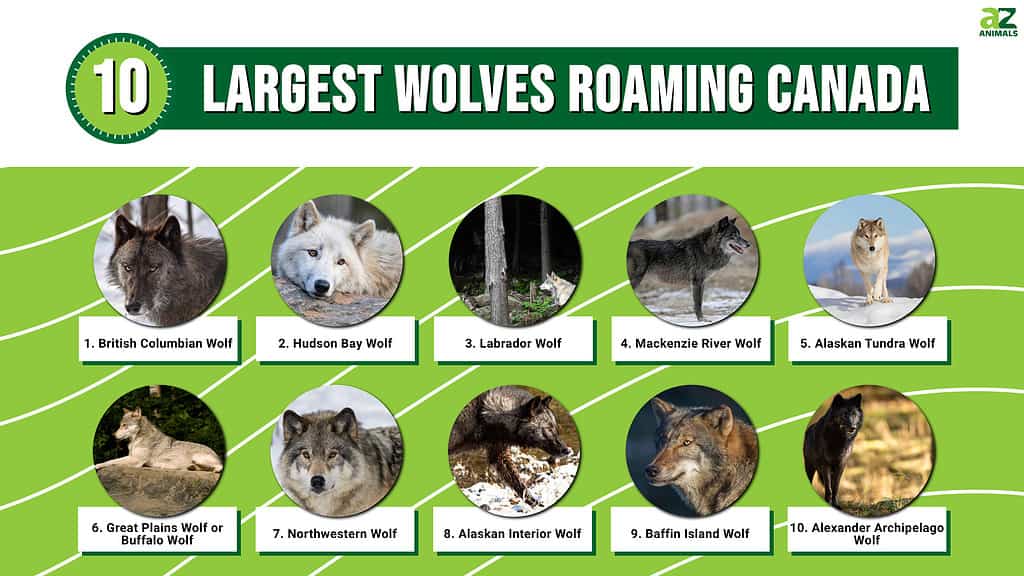
How Many Species of Wolves Are There?
To start with, let’s clarify the broad categories. Two species of wolves are universally recognized: the gray wolf (Canis lupus) and the red wolf (Canis rufus). The former has a vast range that spans the Northern Hemisphere, including North America, Europe, and Asia. In contrast, the latter is highly endangered and native to the Southeastern United States.
Gray wolves are the larger of the two species, known for their thick fur, which comes in a wide variety of colors, from pure white to a mix of browns, grays, and blacks. They are social creatures that live in packs, each with its territory, often led by an alpha pair.
On the other hand, red wolves are smaller and have a distinct reddish-tan coat. Historically, their population was greatly diminished due to factors like habitat loss and hybridization with coyotes. Today, they are one of the rarest canids in the world.
Apart from these, there is another debated species, the Eastern wolf (Canis lycaon or Canis lupus lycaon), which some scientists believe to be a separate species. In contrast, others argue it is a hybrid of gray wolves and coyotes or a subspecies of the gray wolf. Eastern wolves primarily inhabit the northeastern part of North America.
Now, let’s delve into the extraordinary world of Canadian wolves, focusing on some specific subspecies of Canis lupus, or the gray wolf. The journey takes us from the temperate rainforests of British Columbia to the expansive tundra of Hudson Bay and the rugged landscapes of Labrador. Each subspecies we encounter represents a unique expression of life’s incredible adaptability, showcasing distinctive behaviors, appearances, and habitats.
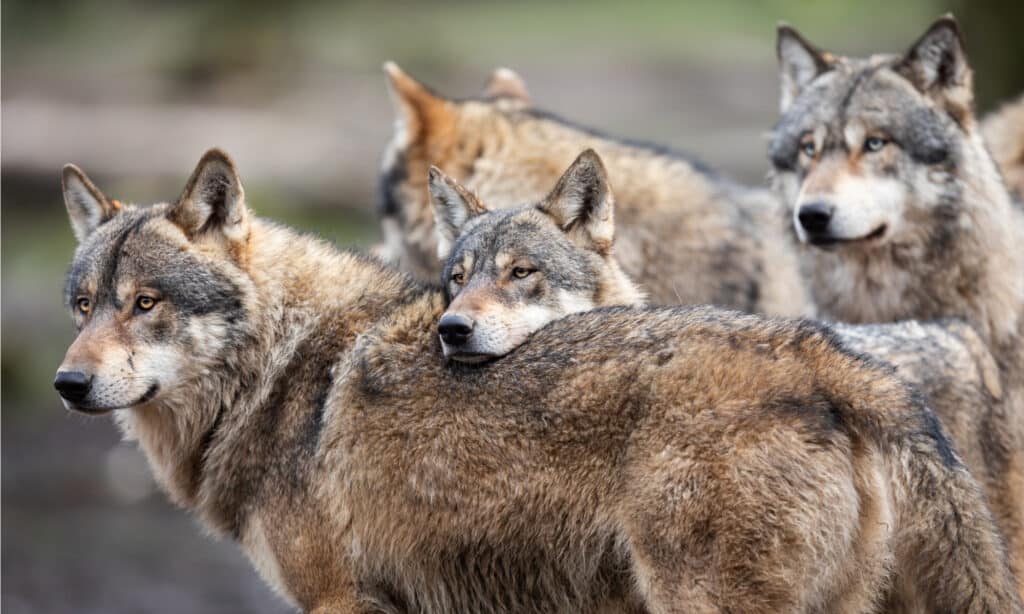
There are two species of wolves; the gray wolf (
Canis lupus) and the red wolf (
Canis rufus).
©AB Photographie/Shutterstock.com
10 Largest Wolves Roaming Canada
| Wolf Subspecies | Scientific Name |
|---|---|
| British Columbian Wolf | Canis lupus columbianus |
| Hudson Bay Wolf | Canis lupus hudsonicus |
| Labrador Wolf | Canis lupus labradorius |
| Mackenzie River Wolf | Canis lupus mackenzii |
| Alaskan Tundra Wolf | Canis lupus tundrarum |
| Great Plains Wolf or Buffalo Wolf | Canis lupus nubilus |
| Northwestern Wolf | Canis lupus occidentalis |
| Alaskan Interior Wolf | Canis lupus pambasileus |
| Baffin Island Wolf | Canis lupus manningi |
| Alexander Archipelago Wolf | Canis lupus ligoni |
Canadian subspecies of wolves all live and hunt in packs.
©Michael Roeder/Shutterstock.com
1. British Columbian Wolf (Canis lupus columbianus)
Dwelling in the lush, coastal mainland of British Columbia, Canada, the British Columbian Wolf is a notable subspecies of the gray wolf. Among its distinguishing features is its size. They are one of the larger subspecies, typically weighing between 80 to 150 pounds (36 to 68 kilograms). As with all wolves, the males tend to be larger than the females. Their body length is roughly 4.75 to 6 feet from nose to tail tip.
The coat of the British Columbian Wolf can range from white to black, although many exhibit a blend of grays and browns. The rich, thick fur provides necessary insulation in the cold months and also lends to their imposing appearance.
One of the most interesting aspects of this subspecies is its diet. The British Columbian Wolf has adapted to a rich diet consisting largely of various ungulates. This abundant food source, prevalent in their coastal habitat, contributes to their larger size and robust health. They do resort to marine-based food sources when their preferred food source is scarce.
Finally, behaviorally, these wolves are as agile in water as they are on land. They are excellent swimmers, often chasing their prey into the water or scavenging along the beach. Their diet and plentiful food resources have allowed them to form larger packs than other wolf subspecies. This pack lifestyle enhances their hunting efficiency and strengthens their social dynamics.

The British Columbian Wolf typically weighs between 80 to 150 pounds (36 to 68 kilograms).
©Rose Guinther/Shutterstock.com
2. Hudson Bay Wolf (Canis lupus hudsonicus)
Located primarily in the northeastern reaches of Manitoba and the southwestern corner of Hudson Bay, the Hudson Bay Wolf endures an environment of often bitterly cold and inhospitable terrain. With this challenging habitat as a backdrop, these wolves have developed characteristics that help them thrive where others might falter.
One of the most striking features of the Hudson Bay Wolf is its size. Adult males typically weigh between 80 and 140 pounds (36-63.5 kilograms). Their body length, on average, is 4 to 5 feet from nose to tail tip. Their size, larger than many other subspecies of wolves, offers advantages in hunting and survival in their unique environment.
Moreover, adorning this sturdy frame is a thick coat, crucial for enduring the frigid winters of the Hudson Bay region. These wolves feature fur that varies in color. However, it is often a blend of whites, grays, and browns, which provides excellent camouflage against the snow-covered landscapes they inhabit.
As for diet, the Hudson Bay Wolf preys primarily on caribou and muskoxen, displaying a mastery of group hunting strategies adapted to their open tundra and minimal forest cover environment. They operate in packs, working together to bring down large prey. The persistence and cooperation required for such hunting tasks reveal a complex social structure, demonstrating their familial bonds’ necessity and strength.
Despite the harsh conditions, the Hudson Bay Wolf exhibits an undeterred spirit common among wolves, displaying tenacity, endurance, and adaptability.
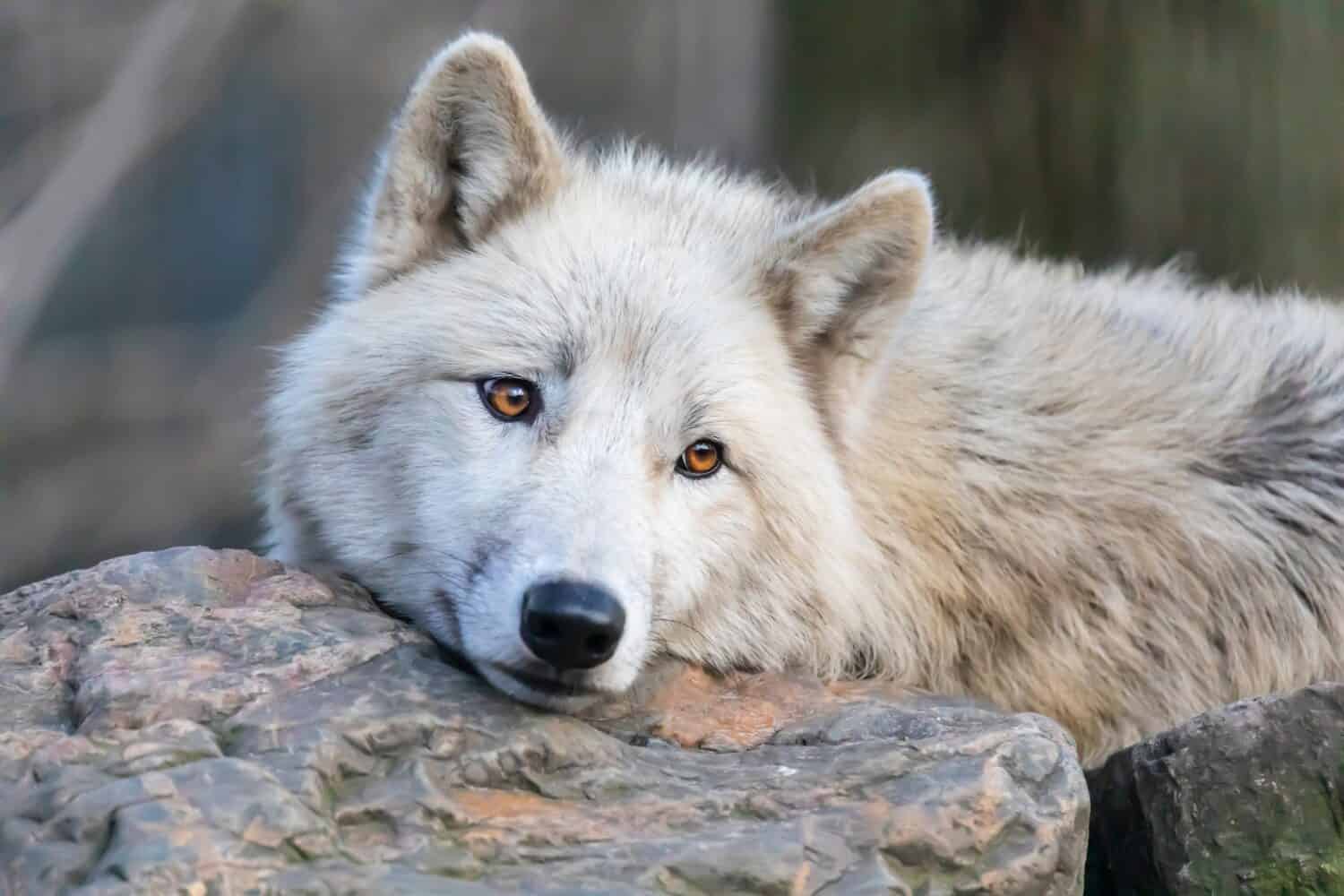
Hudson Bay Wolf is primarily found in the northeastern reaches of Manitoba and the southwestern corner of Hudson Bay.
©Edwin Butter/Shutterstock.com
3. Labrador Wolf (Canis lupus labradorius)
The Labrador Wolf is found mainly in Labrador and Quebec. It’s a moderately large wolf, with males typically weighing between 64 to 100 pounds (29 to 45 kilograms). Their body length is roughly 4.5 to 6 feet. Females are slightly smaller, but all members of this subspecies share a common adaptability to their often harsh and remote environments.
Their coats are as varied as the landscape they inhabit, ranging from pure white, emblematic of the snow-covered landscapes of the Canadian North, to various shades of gray and black. Their coats provide necessary insulation during the brutal winters and act as effective camouflage while hunting.
Furthermore, speaking of hunting, the Labrador Wolf primarily preys on caribou and moose. Working in packs, they demonstrate remarkable teamwork and strategy to bring down such large prey. This pack behavior also contributes to their social structure, fostering bonds critical for survival in the harsh Canadian wilderness.
Finally, Labrador Wolves play a crucial role in their ecosystem despite the harsh climate and often challenging conditions. By preying on large ungulates, they help maintain the balance in their environment and contribute to the overall health of their habitat.

The Labrador Wolf typically weighs between 64 to 100 pounds (29 to 45 kilograms).
©Klaus Balzano/Shutterstock.com
4. Mackenzie River Wolf (Canis lupus mackenzii)
The Mackenzie River Wolf is found mainly along the Mackenzie River valley, which includes parts of the Northwest Territories and Yukon. This subspecies is among the larger ones, with males typically weighing between 85 to 150 pounds (38.5 to 68 kilograms). The body length of the Mackenzie River Wolf can span 5 to 5.5 feet on average. Their size gives them a significant advantage when hunting large ungulates, their primary prey.
Their coats reflect a beautiful array of colors, ranging from pure white to black, although gray and blends of gray are the most common. This assortment of colors offers practical benefits such as camouflage and protection against the harsh winter cold and adds to their distinct aesthetic appeal.
Moreover, the Mackenzie River Wolf subsists primarily on ungulates like moose, caribou, and muskoxen. They hunt in packs in a coordinated symphony of agility and power, demonstrating sophisticated teamwork that reflects their complex social structure. This pack behavior maximizes their hunting success and forms the basis of their societal interaction.
In addition, these wolves in Canada are known for their elaborate communication methods that include a broad spectrum of howls, barks, growls, and other vocalizations. These sounds, far from arbitrary, convey complex messages crucial for maintaining pack structure, territory, and communal harmony.
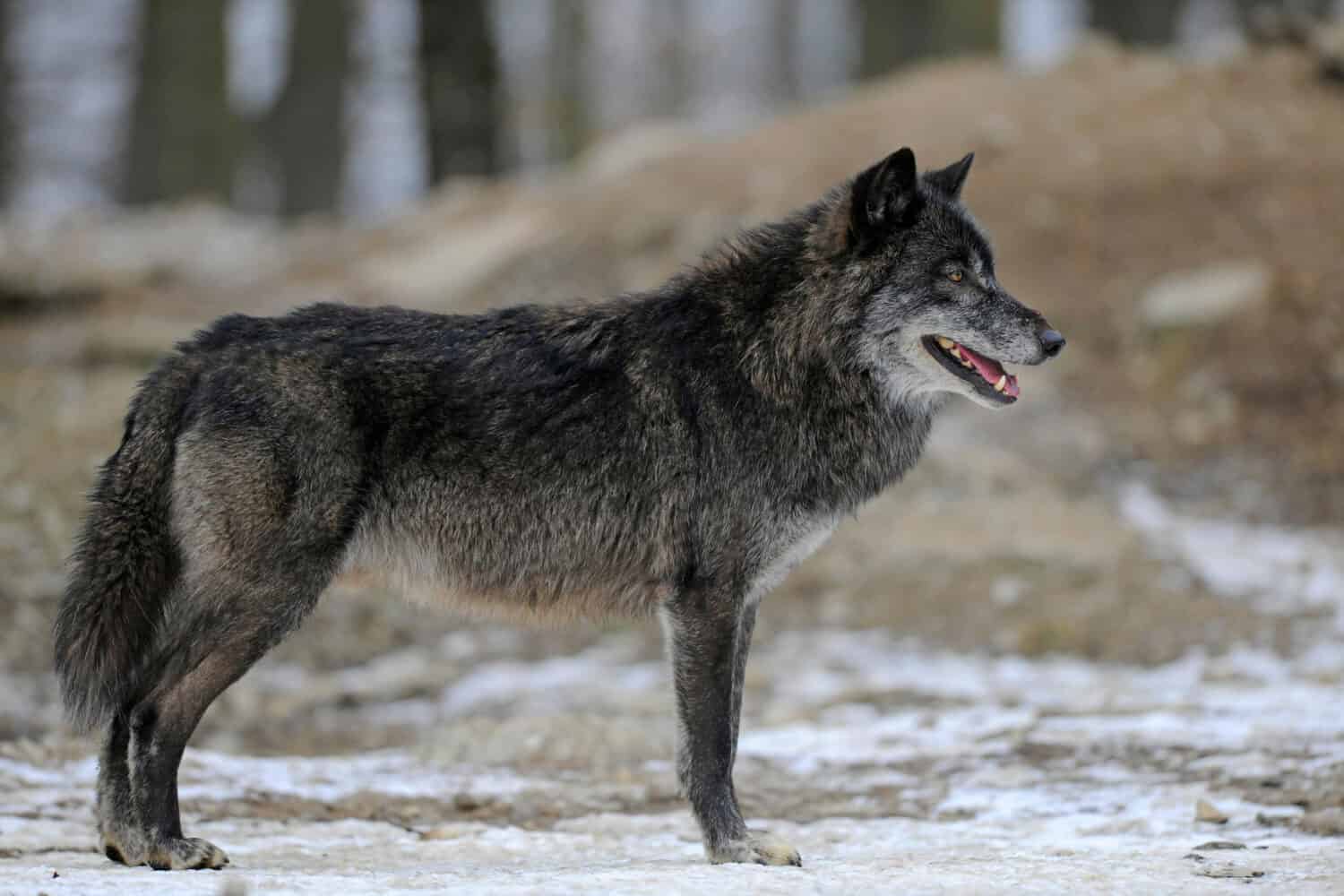
The Mackenzie River Wolf is located along the Mackenzie River valley, which includes parts of the Northwest Territories and Yukon.
©imageBROKER.com/Shutterstock.com
5. Alaskan Tundra Wolf (Canis lupus tundrarum)
The Alaskan Tundra Wolf is native to the Arctic regions of Alaska and Canada, specifically around the Arctic Circle. Among the larger subspecies of gray wolves, the adult Alaskan Tundra wolf can weigh between 85 to 150+ pounds (38.5 to 68+ kilograms), with males typically larger than females. Some males have been known to reach upwards of 180 pounds. The body length of this wolf is roughly 4.5 to 7 feet from nose to tail tip.
Their fur, a thick double-layered coat, is often a mix of grays, browns, and whites but can range to pure white – a perfect adaptation to their icy habitats. The fur is denser than other subspecies, providing critical insulation against freezing Arctic temperatures.
Finally, Tundra Wolves are not picky eaters; they are versatile opportunistic predators. Their diet consists mainly of large ungulates, such as muskoxen and caribou. However, they also consume smaller mammals and carrion when available. In summer, when the Arctic thaws, they even eat birds and their eggs, berries, and river-dwelling creatures, demonstrating impressive adaptability.

The Alaskan Tundra Wolf weighs between 85 to 150+ pounds (38.5 to 68+ kilograms).
©Jim Cumming/Shutterstock.com
6. Great Plains Wolf or Buffalo Wolf (Canis lupus nubilus)
Great Plains Wolves are native to the central plains of North America, stretching from southern Manitoba and Saskatchewan in Canada down to northern Texas in the United States. At present time, they mostly reside in the western Great Lakes region of Canada and the. Adults typically weigh between 64 to 110 pounds (29 to 50 kilograms). Their body length is roughly 4.5 to 6.5 feet from nose to tail tip. They are medium to large-sized wolves, well-built for endurance over the expansive prairies.
Overall, these wolves in Canada sport coats with varied coloration, often displaying mixtures of brown, gray, and black. Their fur protects against the fluctuating weather conditions of their habitat, ranging from freezing winters to hot summers.
The Great Plains Wolf was historically known for its remarkable adaptability in hunting. As the name “Buffalo Wolf” suggests, they were once expert hunters of the American bison. However, with the decline of the bison population, their diet has diversified to include other large ungulates like deer and elk, as well as smaller mammals and carrion.
Once abundant across the prairies, the Great Plains Wolf faced near extinction due to extensive hunting and habitat loss. However, conservation efforts have helped their populations recover in some areas, signifying a promising step toward survival.
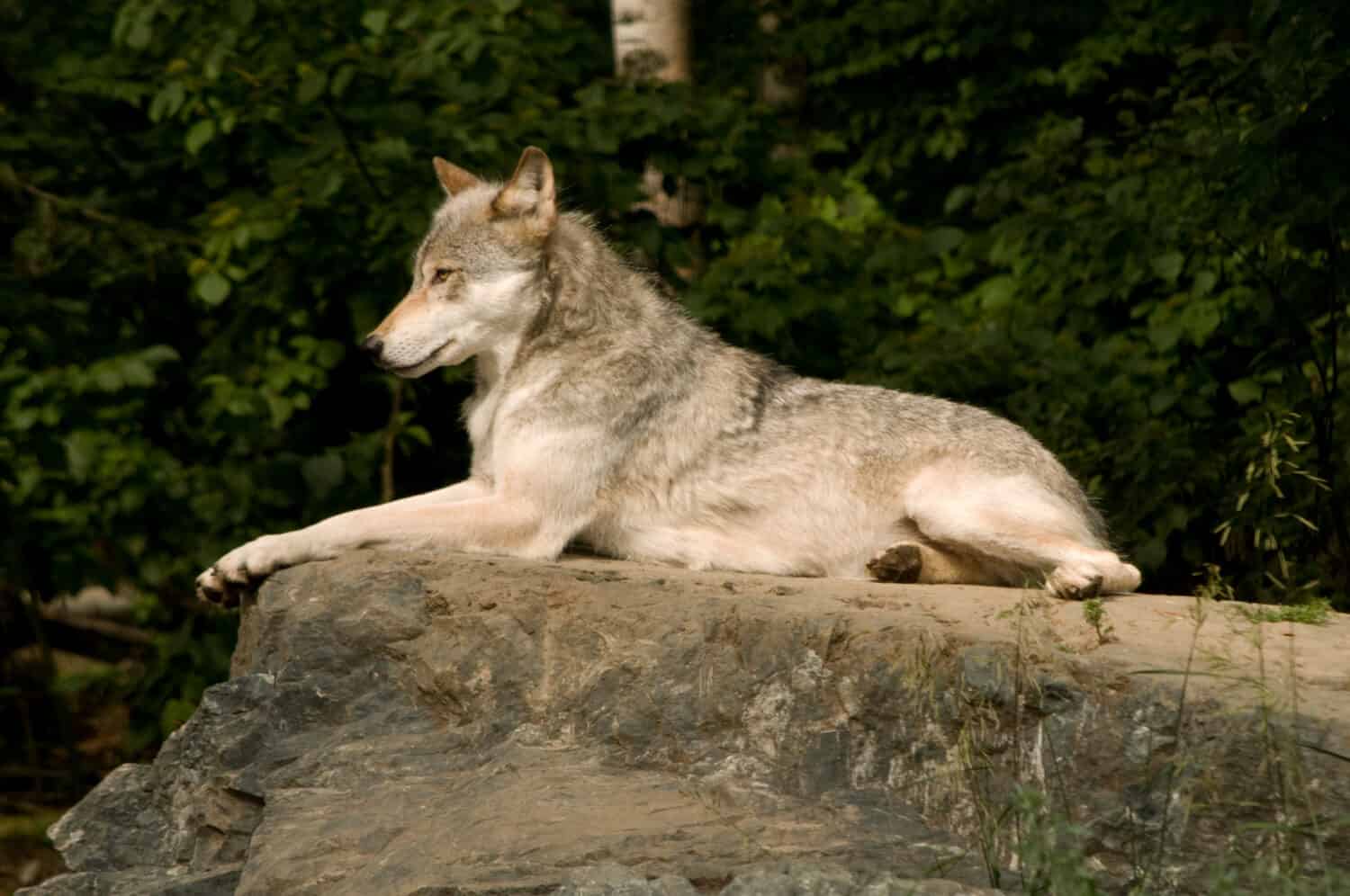
The Great Plains Wolf nearly went extinct due to overhunting and habitat loss.
©Carol Heesen/Shutterstock.com
7. Northwestern Wolf (Canis lupus occidentalis)
The Northwestern Wolf, also known as the Rocky Mountain Wolf or Canadian Timber Wolf, is native to western North America, specifically areas spanning from Alaska through the Canadian provinces of Yukon, British Columbia, and Alberta and down into the United States Rocky Mountains. They’re among the largest wolves in the world, with adults weighing between 80 to 150+ pounds (36 to 68+ kilograms). The body length of these wolves, on average, is 5 to 7 feet.
Furthermore, their coat colors vary considerably, ranging from nearly pure white to black and several shades of gray and brown in between. The dense double-layered fur helps these wolves survive the harsh, cold winters in their native habitats.
The Northwestern Wolf’s diet primarily includes large ungulates, such as elk, moose, and caribou. However, they demonstrate adaptability when larger prey is scarce and hunt smaller animals, such as rabbits and beavers. During times of food scarcity, they can also resort to scavenging.
Equally like most wolves in Canada, they live and hunt in packs that typically consist of an alpha pair and their offspring. This pack structure facilitates cooperative hunting, territory defense, and pup rearing, highlighting their intricate social bonds and complex communication methods.
The history of the Northwestern Wolf is marked by its near eradication from the lower 48 U.S. states by the mid-20th century due to widespread hunting and habitat loss. However, their populations are now recovering due to conservation efforts, including reintroduction programs in places like Yellowstone National Park.

The Northwestern Wolf is also known as the Rocky Mountain Wold or the Canadian Timber Wolf.
©Mircea Costina/Shutterstock.com
8. Alaskan Interior Wolf (Canis lupus pambasileus)
This wolf subspecies, unique to the remote regions of Alaska and Western Yukon in Canada, is a significant player in the Arctic ecology. Adult Alaskan Interior Wolves typically weigh between 68 to 130 pounds (30 to 59 kilograms). Their body length is roughly 5 to 6.5 feet. They are among the larger wolf subspecies suited to the harsh conditions and large prey animals of their native habitats.
Furthermore, the fur of the Alaskan Interior Wolf is thick and plush, a vital adaptation for surviving the frigid Arctic winters. Coat colors can range from white through various shades of gray and brown to black, offering a stunning contrast against the snow-covered landscapes they inhabit.
The diet of these wolves in Canada predominantly comprises large ungulates such as moose, caribou, and Dall sheep. However, in times of scarcity, they can adapt to hunting smaller mammals, including hares and rodents. Their exceptional hunting skills and adaptability help them thrive in the harsh, often unpredictable Arctic conditions.
In addition, their habitats are mostly remote, thus limiting their contact with humans. Consequently, Alaskan Interior Wolves have not suffered from the extensive hunting and habitat loss experienced by their cousins in more southern locales. However, challenges such as climate change and mineral exploration pose potential threats to their survival.
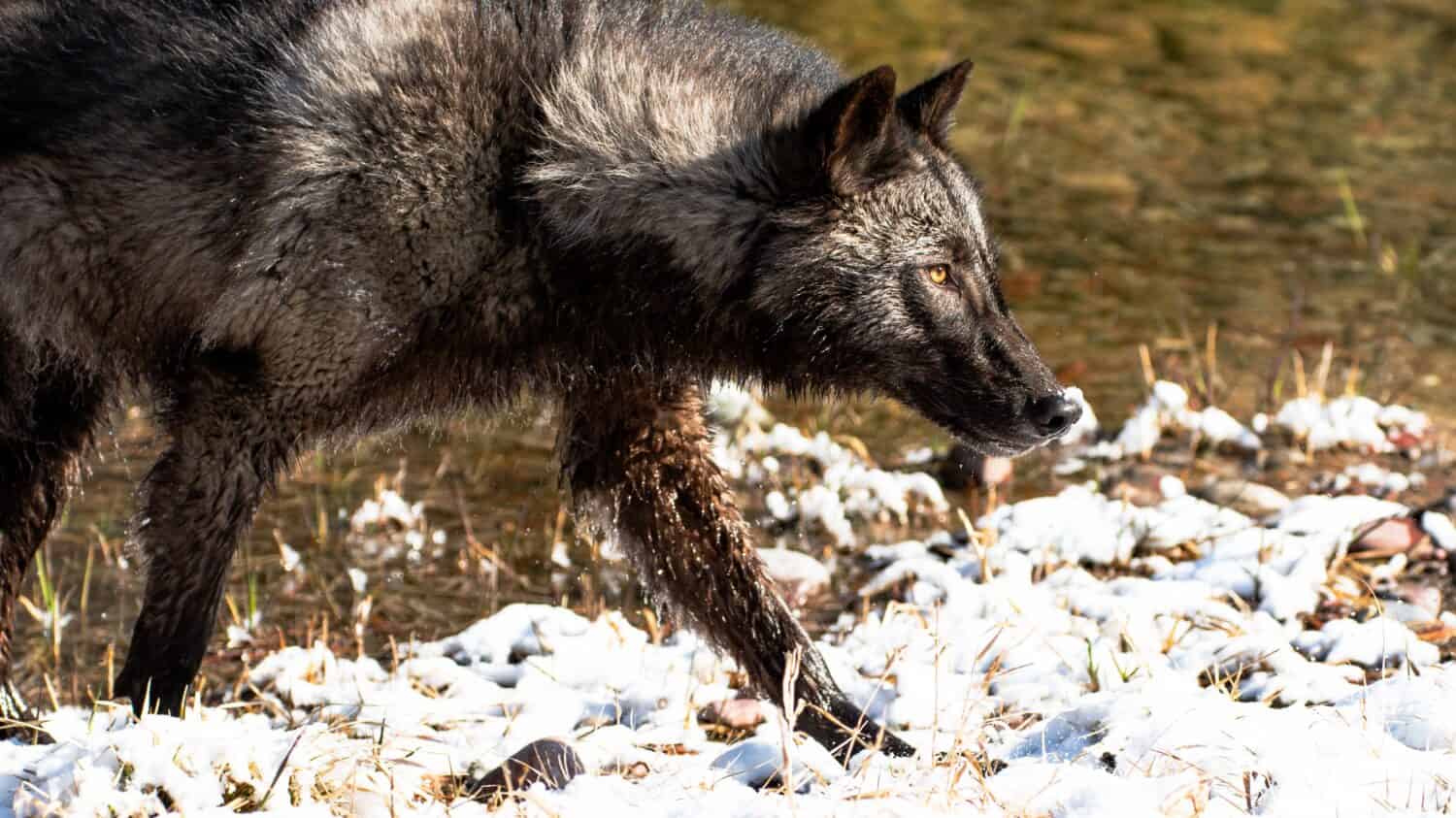
The Alaskan Interior Wolf typically weighs between 68 to 130 pounds (30 to 59 kilograms).
©Wirestock Creators/Shutterstock.com
9. Baffin Island Wolf (Canis lupus manning)
The Baffin Island Wolf inhabits the remote Baffin Island in the Canadian territory of Nunavut. The wolves here are somewhat smaller than their mainland counterparts due to the island rule, a biological principle stating that animals isolated on an island tend to change in size over time. Males of this subspecies weigh between 30 to 50 pounds (13.5 to 22.5 kilograms). Their body length is roughly 3 to 3.5 feet from nose to tail tip.
Their fur is typically white, an effective camouflage against the snow-laden landscapes they inhabit. This dense, double-layered coat provides the necessary insulation, allowing the Baffin Island Wolf to withstand the harsh Arctic temperatures.
Lastly, Baffin Island Wolves primarily feed on Arctic hares and caribou, which roam the tundra in significant numbers. They’ve adapted to the challenges of hunting in their snowy domain, demonstrating remarkable agility and endurance. Pack hunting, a trademark of wolf behavior, is especially important here due to the physical demands of capturing such hardy prey in this unforgiving environment.
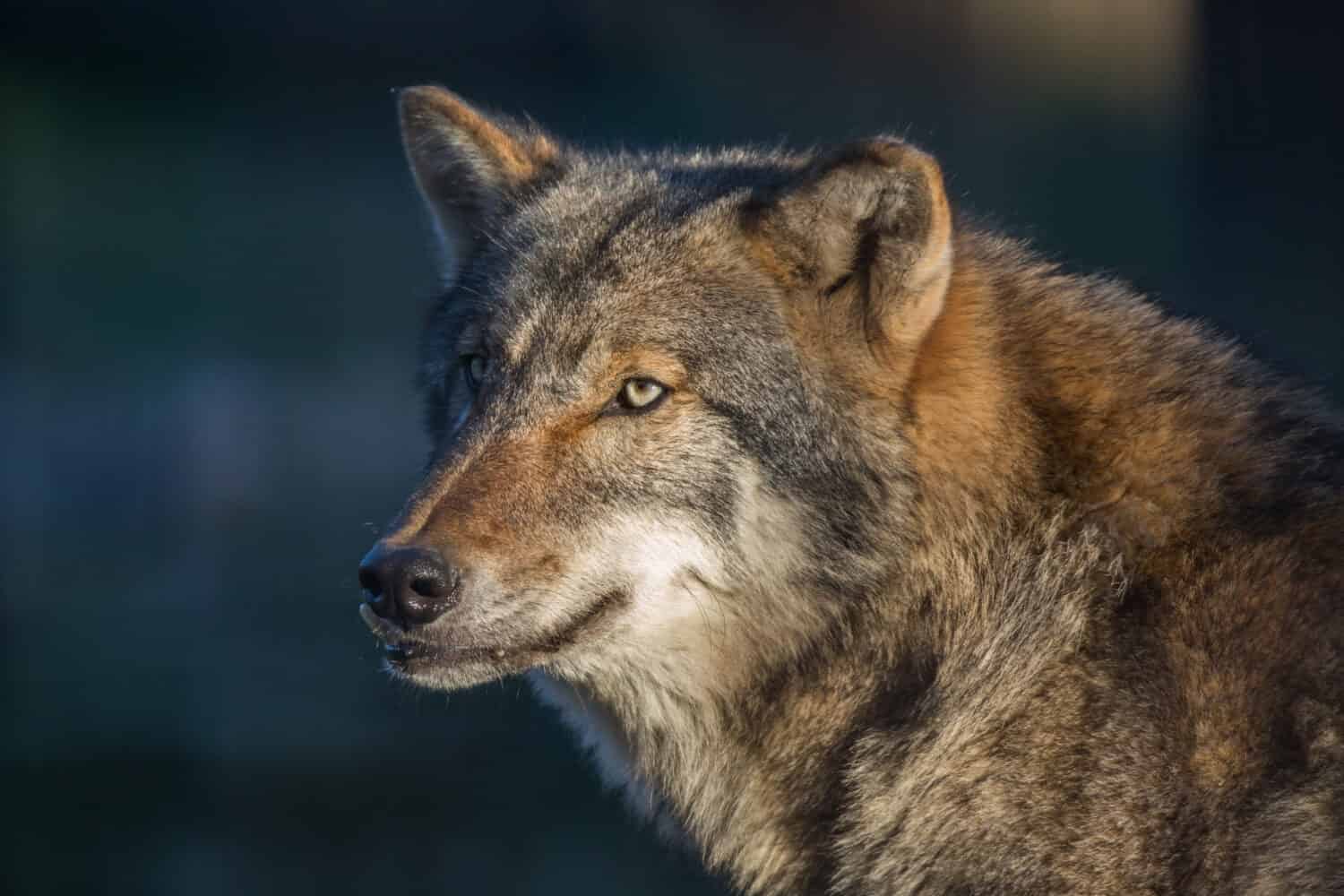
The Baffin Island Wolf is found on the remote Baffin Island in the Canadian territory of Nunavut.
©Szczepan Klejbuk/Shutterstock.com
10. Alexander Archipelago Wolf (Canis lupus ligoni)
The Alexander Archipelago Wolf, a smaller subspecies of the gray wolf, makes home primarily within the confines of the Alexander Archipelago in Southeast Alaska. Some even reside in the adjoining mainland of British Columbia. Similar to the Baffin Island Wolf, these males typically weigh between 30 to 50 pounds (13.5 to 22.5 kilograms). The body length is roughly 3 to 3.5 feet. Furthermore, their size, smaller than many other wolf subspecies, is thought to be an adaptation to the island environment they inhabit and the availability of prey.
The fur of these wolves in Canada varies, presenting an array of colors from black to a cinnamon and gray mix. However, dark-furred individuals are more common. This dark fur provides an effective camouflage in their rainforest habitat. It also offers essential protection from the cold and wet conditions prevalent in their environment.
Moreover, much like their British Columbian Wolf relatives, their diet mainly consists of ungulates. The Alexander Archipelago Wolves are skilled hunters and not averse to swimming to pursue their prey. Sitka black-tailed deer make up the majority of their diet. However, they also consume marine life. This can include seals, otters, and salmon. These wolves exhibit versatility in hunting and diet that contributes to their survival in this unique environment.
So, in terms of behavior, they are pack animals, much like other wolf subspecies, exhibiting complex social structures and behavior. Their pack sizes tend to be smaller due to the smaller prey populations in their island habitats.
Finally, this wolf, due to its restricted geographical range and declining prey base, is a subject of conservation concern. Their story highlights the fragile balance between survival, adaptation, and the pressures of environmental change.
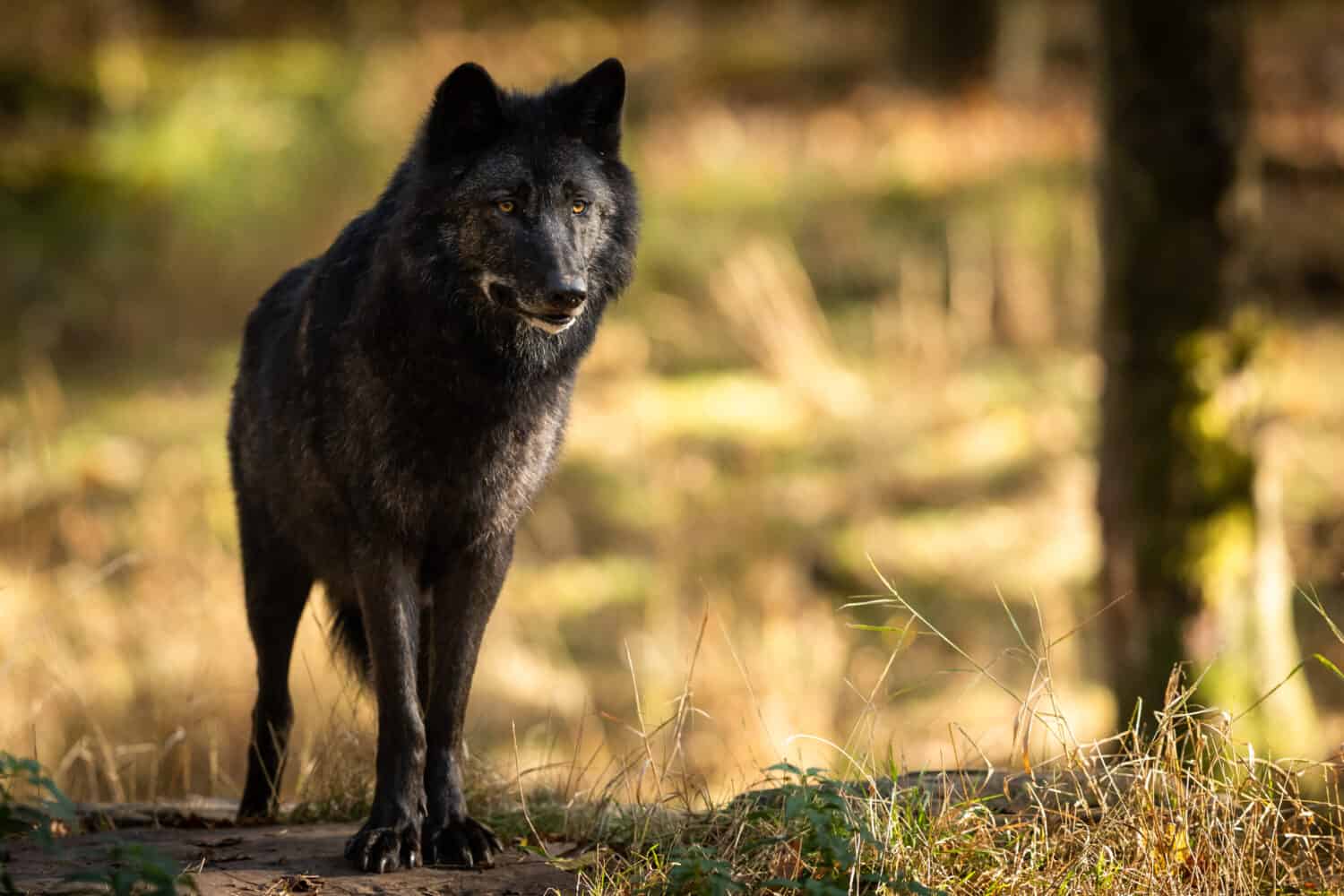
The diet of the Alexander Archipelago Wolf diet primarily consists of deer.
©AB Photographie/Shutterstock.com
Conclusion
In conclusion, the diverse wolf subspecies roaming Canada are a testament to the adaptability and resilience of the Canis lupus species. Each with its distinct characteristics, geographic range, and behavior patterns. From the Northwestern Wolf’s impressive size and ability to adapt to a variety of prey to the unique coat colors and striking social structures of the Alaskan Interior Wolf, the rich tapestry of wolf subspecies inhabiting the wild spaces of Canada is truly remarkable.
Yet, despite their adaptability and natural prowess, these wolves are not invincible. They face a myriad of challenges. Which. includes habitat loss, hunting, and more insidious threats such as climate change and disease. We must continue our efforts to understand these beautiful creatures. They have an integral role they play in our ecosystems. And by doing so, we can better support conservation strategies that will ensure the survival and flourishing of these magnificent animals for generations to come.
Moreover, as we come to appreciate the individual quirks and adaptations of each wolf subspecies, we also acknowledge their common bonds. This includes their sophisticated social structures and their exceptional hunting skills. In addition to their embodiment of the wild, untamed spirit of the landscapes they inhabit. In a sense, they mirror our societies, highlighting the importance of family, adaptability, and respect for our shared environment.
May the magnificence of wolves inspire us all to advocate for their protection and survival in the wild. As to ensure that the howl of the wolf continues to echo through the Canadian wilderness.
Summary of the 10 Largest Wolves Roaming Canada
| Rank | Wolf | Weight | Length |
|---|---|---|---|
| 1 | British Columbian Wolf | 80 to 150 pounds | 4.75 to 6 feet from nose to tail tip. |
| 2 | Hudson Bay Wolf | 80 to 140 pounds | 4 to 5 feet from nose to tail tip |
| 3 | Labrador Wolf | 64 to 100 pounds | 4.5 to 6 feet |
| 4 | Mackenzie River Wolf | 85 to 150 pounds | 5 to 5.5 feet on average |
| 5 | Alaskan Tundra Wolf | 80 to 150+ pounds | 4.5 to 7 feet from nose to tail tip |
| 6 | Great Plains Wolf or Buffalo Wolf | 64 to 110 pounds | 4.5 to 6.5 feet from nose to tail tip |
| 7 | Northwestern Wolf | 80 to 150+ pounds | 5 to 7 feet |
| 8 | Alaskan Interior Wolf | 8 to 130 pounds | 5 to 6.5 feet |
| 9 | Baffin Island Wolf | 30 to 50 pounds | 3 to 3.5 feet |
| 10 | Alexander Archipelago Wolf | 30 to 50 pounds | 3 to 3.5 feet |
The photo featured at the top of this post is © Edwin Butter/Shutterstock.com
Thank you for reading! Have some feedback for us? Contact the AZ Animals editorial team.






